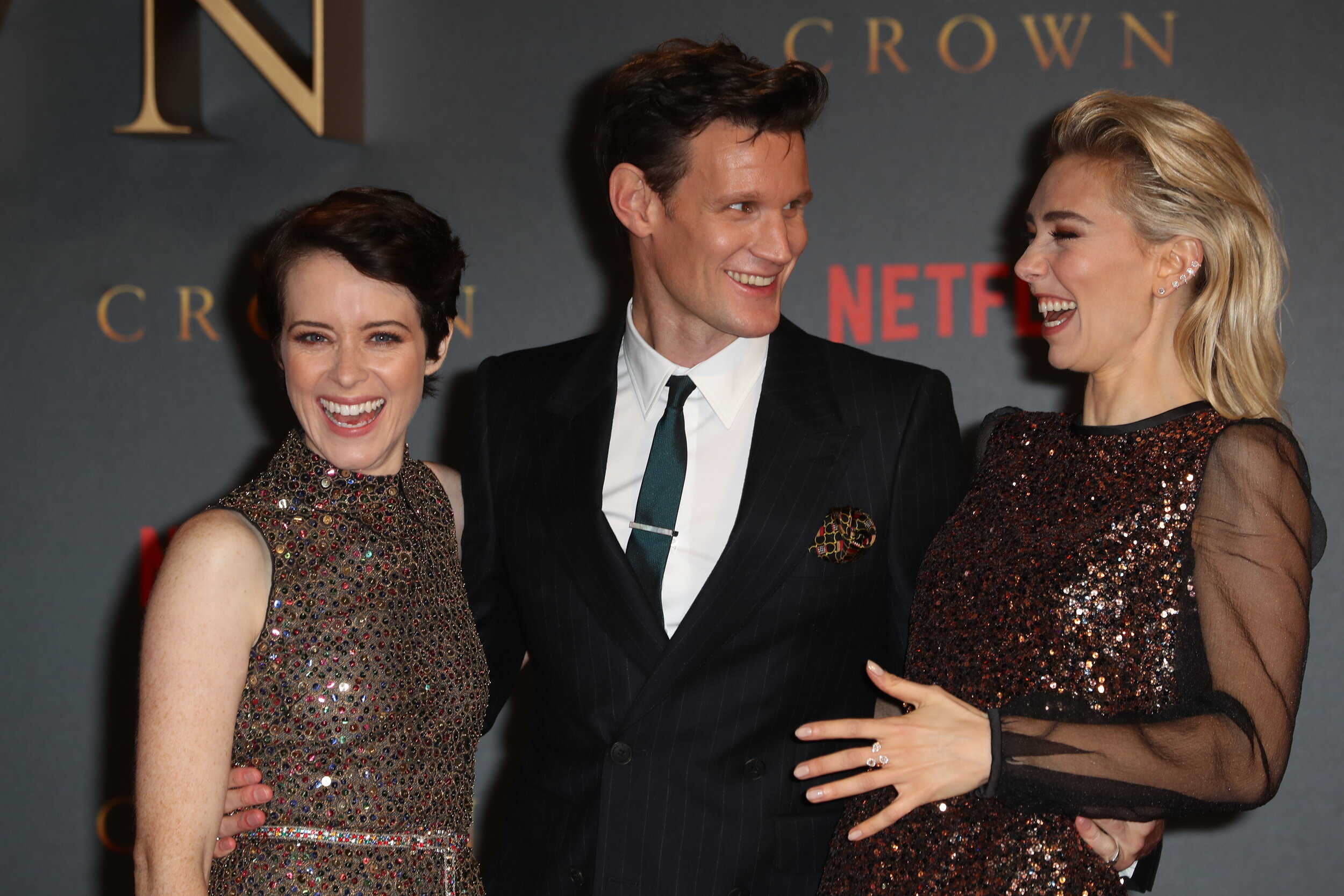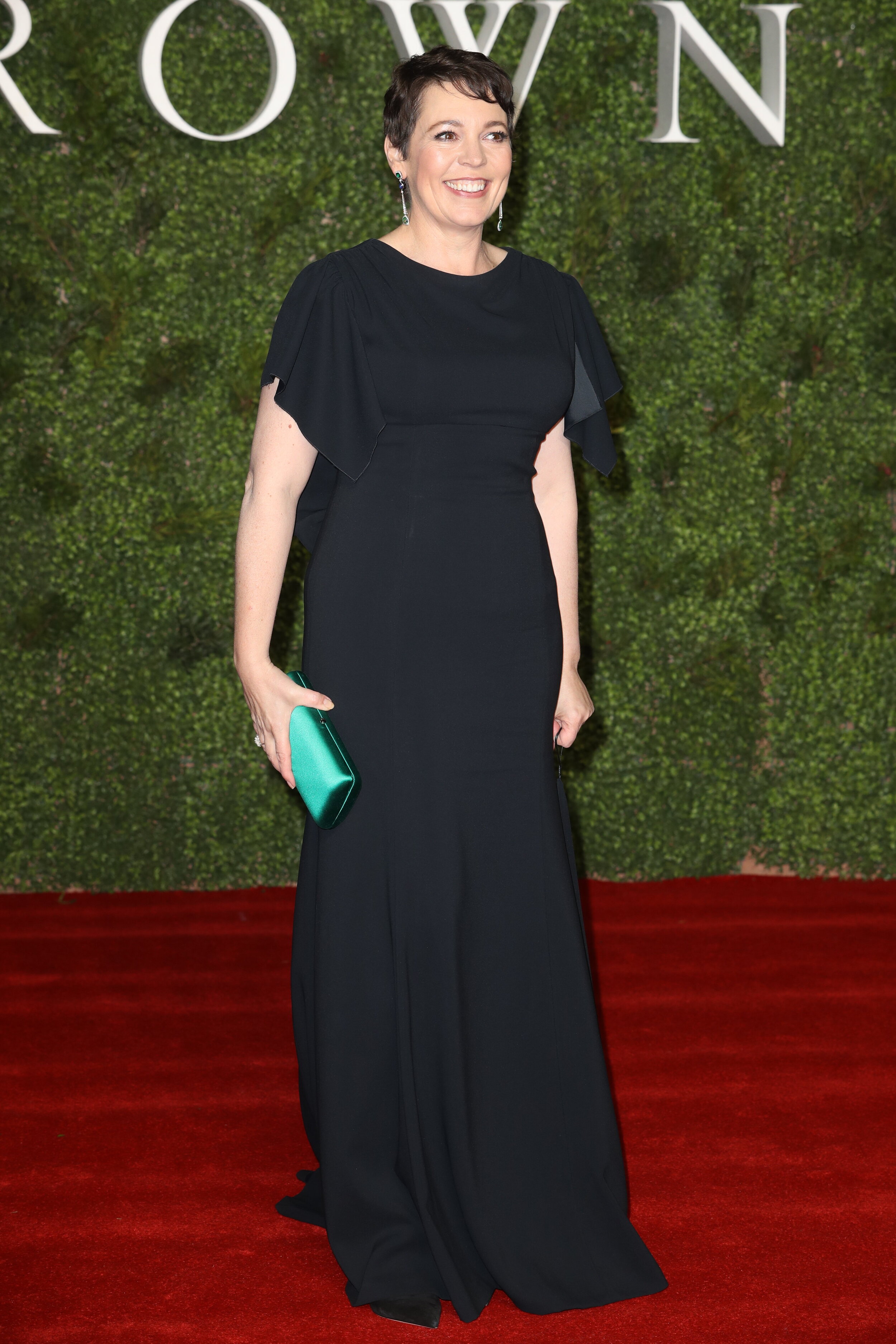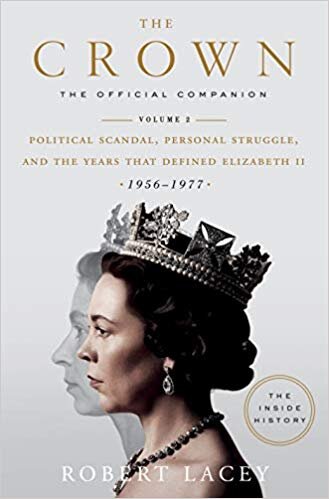The Crown is Not Real Life!
Claire Foy, Matt Smith and Vanessa Kirby, aka the Queen, Prince Philip, and Princess Margaret, at the Crown season two premiere in London in 2017. i-Images / Polaris
Are you watching the Crown? The answer, I’m guessing, is some form of OBVIOUSLY. It is irresistible for even the most casual royal fan, a chance to watch the reign of Queen Elizabeth II unfold in a delicious Netflix dramatization. I absolutely devoured the first two seasons.
But I’ll be honest, the more I report on the royal world, the more dangerous I find the series. The creators have done such an admirable job recreating the sets and the costumes that it’s easy to lose yourself in the Crown — and forget that it takes extraordinary creative liberties. It is not real, even though it feels so darn real, both the major monarch milestones and especially the more intimate dialogue. “Beneath its enticing veneer, much of it is, in modern parlance, fake news,” wrote Alastair Bruce, a journalist and television commentator, in his scathing critique of the series published in the Spectator. “Those falsehoods will be accepted by many millions of people around the world as truths.”
Do not despair! You can still enjoy the Crown responsibly, as I strive to do, with the help of Robert Lacey. A journalist and historian, Lacey has been writing about the royal family since the 1970s and worked with the Crown’s creator Peter Morgan on the film the Queen. Lacey serves as the Crown’s historical consultant, collaborating with Morgan via meetings and phone calls as the scripts came together. He has penned two official companion guides, too, so we can avoid the “Is [fill in the blank moment] true?” endless Googling and its questionable results (I am definitely guilty of that!). His second book, entitled The Crown: The Official Companion, Volume 2: Political Scandal, Personal Struggle, and the Years that Defined Elizabeth II, was just published and tackles season two and three.
I recently had a fascinating conversation with Lacey recently about how — and why — the Crown dramatizes events, and couldn’t resist asking for his thoughts on royal fashion and the Prince Andrew debacle. Lots to think about below!
Note: This conversation has been condensed and edited for clarity.
Olivia Colman takes over as the Queen in the third season of the Crown. (i-Images/Polaris; Sophie Mutevelian / Netflix)
As the historical consultant on the Crown, where do you begin? And how do your companion books fit into that?
Robert Lacey: I make a very important distinction at the beginning of the book between the past and history. They're two different things. The past is human life as it was actually lived. Millions and billions and trillions of people’s loves and hopes and despairs and dreams, which have all happened and died. The historian comes along like a gardener, holding out a sieve for the past. The rich soil of the past goes through the sieve and the gardener — he’s very proud at the end of the process — says, “Look, here’ some pebbles, here’s some stones, here’s some roots, this is my evidence. This is history.”
The historian, and I include myself in this criticism, has missed the essence, which is passed through the sieve and that you can only retrieve by imagination. Not by wild, unstructured imagination. You need historical knowledge. What Peter Morgan does is go underneath the sieve, he imagines what might have happened.
Can you give me an example of what is imagined?
RL: At the beginning of season two, the Queen buys her husband a camera as a present for him to take on his tour. She goes to put it in his briefcase and discovers a photograph of a Russian ballerina, Ulanova. She was a great ballerina from the Bolshoi Ballet in those days. Now [the placement of that photograph] is totally imaginary. It’s meant to symbolize and give shape to the complicated issue of whether or not Prince Philip was faithful.
It’s a very difficult personal area to discuss. If you're dramatizing the life of the Queen, you can’t ignore the fact that there have been many rumors that her husband hasn't been faithful. But they’re no more than that. They’re rumors. Nobody knows. So how do you recreate that on the screen? Do you create affairs that he may never have had? Or do you pretend he is pure as the driven snow? Or do you invent a photograph of a Russian ballerina that goes into his briefcase?
Lacey’s new book explains the real events behind season two and three.
How do you decide when and where to add in these fictional bits?
RL: If some history gets changed in the Crown, then we discuss it very carefully and decide what are we going to change and why. It's not done through ignorance. It's done on the basis of deep research.
One of the most criticized inventions is in the second season that I write about in the book. We see Prince Philip as a boy misbehaving at school. He gets detention and he can’t go see his sister in Germany. So she flies to him and the plane crashes and she dies with her children. Now that actually happened — his favorite sister did die in this way — but people have criticized Peter Morgan and the Crown for inventing, not the death, but Philip's culpability.
In this case, Peter Morgan wanted to convey the sense of guilt that children often feel when the loved adult in their life dies. Though the child has no blame at all for what happened, children feel guilty. That's what Peter was trying to create. Now, rightly or wrongly, you can have your view on that. Apparently Prince Philip was personally upset when he heard about this, I’ve been told this the other day by somebody. I believe it. I’m not going to stand up and defend nor criticize what was done. I'm just trying to explain why this dramatic action was presented in this way. This is the reason for it. You can accept it or you can reject it.
Is there any danger in people thinking this is a historical representation of what happened when it is a dramatization?
RL: There is a danger of that. We go to enormous lengths to make the costumes and settings absolutely accurate, historically. That is not to deceive people, not from our end. That is to create a facsimile of how things were. The point of the book is to address this very issue you’re talking about. The book sets out to separate history from invention. I don’t call it fact and fiction because fiction suggest something that’s untrue. There are different sorts of truths.
Chapter 17, called Moon Dust, it’s about how Prince Philip found his spiritual faith. He was absolutely fascinated by the American astronaut program and then the landing on the moon. The astronauts came to Buckingham Palace and he asked to have special time with them thinking that up in the heavens there they would have discovered some extra secret of life. And they hadn’t. No disrespect to Neil Armstrong or Buzz Aldrin, but they were human beings like everybody else.
Philip turns to a project closer to home, called St. George’s House in Windsor Castle, which is a sort of hostel for burned out vicars and ministers and clergymen who had done 20 to 30 years in their parish and were losing their way. This is a real thing, St. George’s House, they come there to be emotionally recharged. By getting involved with their work, Prince Philip found that he was discovering faith as well.
Here’s the rub: both elements are true but in fact Prince Philip had found faith through St. George’s House before men landed on the moon. This is an example of how Peter Morgan has taken some historical events and has transposed them, he switched the dates around. Some people would say that he's done violence to history. For me, he has conveyed Prince Philip’s spiritual discovery, but more powerfully.
I’m struck by what you said about going to great lengths to get the costumes right, because it does lend considerable authenticity to the show. What are your thoughts on royal fashion? What role does it play?
RL: There's an enormous amount of work done on the Crown to duplicate the dress. In one of the episodes in season three involves the investiture of Prince Charles as Prince of Wales in 1969. Obviously his costume, his robes, and his crown have being duplicated minutely. The Queen was wearing a very striking cream outfit with a slightly strange, medieval sort of headgear to reflect the ceremonial nature of the situation.
Royal fashion is right at the heart of the representative monarchy. These royal characters are actors and the clothes they are wearing are stage costumes intended to achieve a particular effect. Dress, and what you wear, is an homage to the importance of the occasion. The royals have to draw a very fine line. They do have to look smart for an occasion, for any public occasion. They don’t want to be so nondescript that people either criticize them or fail to notice them.
I have to ask for your take on the Prince Andrew situation. What do you make of it?
RL: Prince Andrew has got out of step with popular feeling and it's both sad, but also to me, it's something to celebrate. The humane values of the British people come into play. People have said, “We do not want this man and his unsympathetic attitudes being part of our figurehead family. He's not somebody we admire.”
The allegations made against Prince Andrew have not been proven and they may never be proven. But what we do know is that he went on television on Saturday night and gave a display of the most extraordinary arrogance, insensitivity and lack of awareness of what his friend — his convicted friend — did to his women victims. Over the days that followed, the various companies and organizations associated with him said, “No thank you. We don't want this man representing us.” Before too many people said that and issued that humiliation, he surrendered. Although it sounds from what we're hearing now, he only surrendered because the Queen and Prince Charles were absolutely firm with him and said, “You've got to go.”
There are only three characters like him in English history: there’s him, there’s Edward VIII who abdicated in 1936, and there’s King Charles I, who had his head cut off in 1649 because he offended the will of Parliament. We live in historic times.
Robert Lacey is a historian, author, and historical consultant on the Crown. His new book, The Crown: The Official Companion, Volume 2: Political Scandal, Personal Struggle, and the Years that Defined Elizabeth II, is out now.




